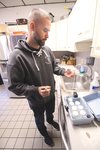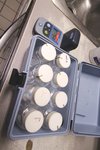By JOHN HOWELL Brian DeLuca is in and out of the Warwick Country Club four days a week year round - even in the winter months when the club is closed. He heads for the kitchen and turns on the water. He's been doing it for about eight years. So, that
This item is available in full to subscribers.
We have recently launched a new and improved website. To continue reading, you will need to either log into your subscriber account, or purchase a new subscription.
If you are a current print subscriber, you can set up a free website account by clicking here.
Otherwise, click here to view your options for subscribing.
Please log in to continue |
|


Brian DeLuca is in and out of the Warwick Country Club four days a week year round – even in the winter months when the club is closed. He heads for the kitchen and turns on the water. He’s been doing it for about eight years. So, that makes 1,664 visits to the club and not once to play golf.
The club is one of eight locations he visits starting at 7:30 to 8 a.m. across the city before completing his rounds by late morning. His routine doesn’t change and unless delayed by traffic or weather, his visits are like clockwork.
We met up with him Thursday at 10:15 at Fire Station 6. That’s the one on West Shore Road at Cole Farm. DeLuca fished in his pocket pulling out a key ring. After a few turns, the lock to the back door yielded and he headed for the kitchen. A large screen television played in front of several empty recliners. A bowl of trick or treat candy was on the counter along with a half-eaten cake under a clear plastic cover.
DeLuca headed for the sink, pulling a spray bottle of disinfectant from a satchel. He sprayed the nozzle of the faucet and wiped it down. Then he turned on the cold water and let it run. He was clearing the lines of standing water. He wanted water from pipes that provide water to 26,900 customers before taking a test sample.
Taking a water sample is not as simple as one might imagine. Deluca must first determine the level of chloride in the water. He takes one of two small vials from a plastic box that also contains a tester. He fills the vial to a line on the glass, rips open a paper packet and adds the powdery contents to the water. The water turns pink. DeLuca then places the vial in the reader. Happy with the results, he repeats the process with the second vial. If the readings don’t show excessive levels of chlorine, he fills a small bottle containing a tiny pill to take the sample. The pill neutralizes any chlorine in the sample. The sample is then placed in a cooler for delivery to Rhode Island Analytical. The lab will test all the samples collected for the day for total coliform that includes E. coli.
The presence of coliform in tap water suggests that there could be a problem with the existing equipment or treatment systems, contamination of the source water or a breach in the distribution system, according to the EPA.
If a test shows evidence of bacteria – a “hit” – the water is tested upstream and downstream of the hit. If neither of those tests is positive and a new test of the site proves negative, the assumption is that the sample was contaminated by something outside of the water supply.
DeLuca is careful not to let that happen. He holds his breath while taking the sample and makes sure people aren’t nearby. In the case of samples from kitchen sinks, he makes sure nothing is cooking nearby and a point of avoiding raw chicken that can be a high carrier of bacteria.
So far this year, DeLuca hasn’t come up with a single hit, says Terry DiPetrillo, director of the department. He credits this to the unidirectional program used to flush city lines, which is conducted at night. Starting at the source and using prescribed measures for water pressure, crews flush the system one district at a time. Completing the program takes about three months.
As Warwick is buying water wholesale from Providence, Warwick does not treat it. That is done by Providence. The Consumer Confidence Report mailed annually to customers, which went out to Warwick customers in September show the 14 contaminates tested for Potowomut as well as the rest of the Warwick system were not in SDWA violation or exceeded EPA limits.
The Warwick Water Division purchases water from Providence Water with the exception of Potowomut, which uses water provided by the Kent County Water Authority. In addition, much of the western section of the city, including Apponaug, Cowesett and East Natick, is serviced by the Kent County Water Authority. In total, KCWA provides service to more than 4,000 Warwick customers.
Given the danger it represents and publicity surrounding water systems found to have high levels of lead, especially Flint, Michigan, lead in water is a high health concern. Lead is carefully monitored by the division. Annual testing is done in properties known to have a lead service line. The city is required to test a minimum of 10 percent of properties with lead services on a random basis. Of the 77 remaining properties with lead service, the city tests 30. These properties are older and for the most part in the northern sector of the city and Pawtuxet Village.
Unlike the bacteria test, testing for lead requires the water to have been sitting for about eight hours before a sample is drawn.
DiPetrillo said when he started working for the city more than 20 years ago, about 400 homes had lead service lines. Over the years, the department has been able to replace the majority of those lines, although this may not be a complete fix for the customer.
“We’re only responsible for what’s in the street,” DiPetrillo said of the lead lines. That leaves the homeowner with replacing the lead line coming into the home or extending from there.
Under recently approved legislation, DiPetrillo said, as of 2024 the utility will be responsible to change lead service lines to the house.
He couldn’t put a price tag on lead service replacements as properties vary, but estimated costs could range from $5,000 to $10,000. He urged homeowners replacing lead services to contact the division so that they might work in tandem.
DiPetrillo is hopeful of federal funding through in the infrastructure bill to meet the 2024 requirement to fully replace lead services.
According to the Environmental Working Group’s recently published water quality reports for every zip code in the United States, “
Millions of Americans are unwittingly drinking water that includes an invisible toxic cocktail made up of contaminants linked to cancer, brain damage and other serious health harms,” the EWG says.
The EWG says its report uncovers widespread contamination from toxic substances such as arsenic, lead and the “forever chemicals” known as PFAS in the drinking water of tens of millions of households in all 50 states and the District of Columbia.
“The database also underscores the need for stricter federal water quality standards and a massive injection of funding for badly needed water infrastructure improvements across the country,” the release reads.
The release says anyone can use their zip code to search for a report about all the contaminants and pollutants the local water utility found in their tap water. Water reports are available for each state and include a list of contaminants detected in the tap water above federal and state health guidelines.
In 1974, the Safe Drinking Water Act gave the EPA the responsibility to oversee tap water quality across the U.S. Over the next 47 years, the agency has set maximum contaminant levels, or MCLs – the upper limit of a pollutant legally allowed in drinking water – for more than 90 contaminants.
According to the EWG, water provided by most systems is considered legal according to these limits – but it is hardly safe. In fact, federal oversight of drinking water has been failing for years.
“The EPA has become very good at constantly reassuring the public that all is well with the water coming out of their taps,” said EWG President Ken Cook in a statement. “That message is music to the ears of polluters who’ve fouled source waters and water utilities wary of treatment and infrastructure costs. But it’s just not true – and the EPA’s own scientists know it.”
The EWG claims the EPA’s Office of Groundwater and Drinking Water has added no new contaminants to its regulated list since 2000. Over the past two decades – almost a generation – the EPA has repeatedly punted on setting rules for many unregulated contaminants.
Without legal limits on these chemicals, water systems have no impetus to tackle the contamination from such toxic substances as PFAS, 1,4-dioxane and hexavalent chromium, the chemical made famous by Erin Brockovich’s campaigning.
Many MCLs (maximum contaminant levels) do not reflect the latest science and are woefully out of date. For example, the legal federal standard for nitrate, a fertilizer chemical that often contaminates drinking water, is based on a U.S. Public Health Service recommendation from 1962. More recent studies show that to protect against the risk of cancer, the MCL of 10 milligrams per liter, or mg/L, should be lowered.
The EWG further says the EPA routinely gives more weight to the financial cost of treating contaminated water than to the benefits to public health from stricter regulation.
Federal regulators assess the public health risks of tap water pollutants one chemical at a time, even though drinking water rarely, if ever, contains only one contaminant. In a landmark 2019 peer-reviewed study, EWG researchers found that cumulative exposure to mixtures of 22 toxic chemicals commonly found in U.S. tap water could result in more than 100,000 cancer cases.
Even when sufficiently stringent limits are in place, the EPA and state drinking water programs have limited resources to enforce them. Some systems receive “temporary” waivers for violations for decades claims EWG.
The Beacon was emailed the following statement by Providence Water in response to EWG claims:"The safety and quality of drinking water provided to our customers is Providence Water's top priority. That is why we meet all EPA Safe Drinking Water Act water quality testing requirements and annually publish a Water Quality Report detailing our results available at provwater.com/water_quality <http://provwater.com/water_quality>. Our water quality monitoring and quality control program will continue to meet the requirements of the Safe Drinking Water Act in order to ensure a safe and potable water supply for all our customers."
Comments
No comments on this item Please log in to comment by clicking here